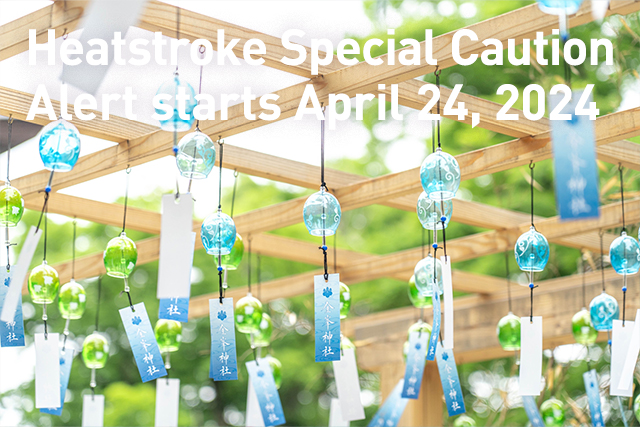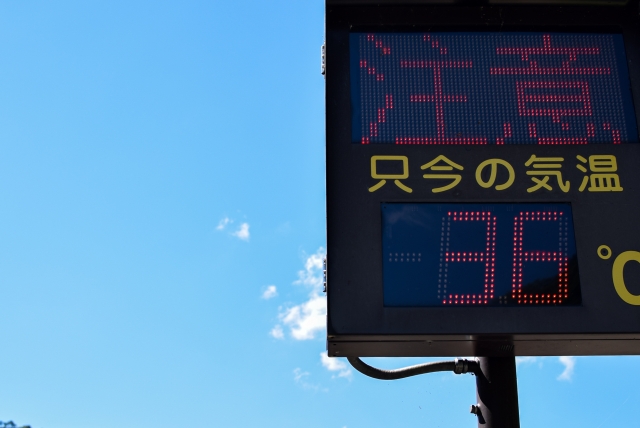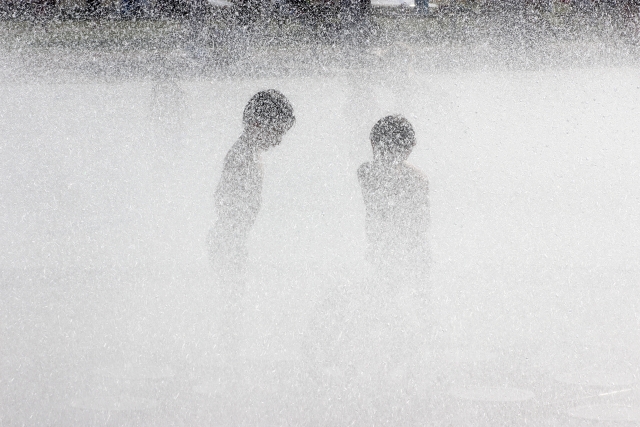Heatstroke Special Caution Aler April 24, 2024
当サイトは広告が表示される場合がございます。
2024年04月24日/お知らせ & コラム

In the event of unprecedented heatwave, Japan will issue a special heatstroke warning.
Starting today (April 24, 2024), a new alert system called the "Heatstroke Special Caution Alert" will be implemented in Japan in response to predicted unprecedented dangerous heat waves, aiming to prevent heatstroke by urging appropriate actions. This new alert, issued by the Ministry of the Environment, is triggered when the "heat index," considering factors like temperature and humidity, reaches 35 or higher at all observation points within a prefecture. It surpasses the existing "Heatstroke Caution Alert," which is issued when the heat index is expected to be 33 or higher at any observation point in a prefecture.

Significance of the Heatstroke Special Caution Alert: Addressing Unprecedented Heat Risks
The "Heatstroke Special Caution Alert" signifies an exceptional level of heat where significant health risks are anticipated. While such extreme conditions have not been observed previously, it prompts local authorities to designate cooling shelters in advance, utilizing public and private air-conditioned facilities, and encourages their opening during alerts to provide relief.
Additionally, administrators such as school principals, business owners, and event organizers are advised to consider measures like canceling outdoor activities or switching to remote work if adequate heatstroke prevention cannot be ensured.

Urgent Measures Against Dangerous Heatwaves: Protecting Vulnerable Populations
A widespread and unprecedented dangerous heatwave may pose significant health risks! Protect yourself and others from the extreme heat by ensuring everyone stays in cool environments. Pay special attention to vulnerable individuals like the elderly and infants, ensuring they have access to air-conditioned spaces. Administrators such as school principals and event organizers should verify heatstroke prevention measures for all attendees, considering cancelations or changes if necessary. Previous heatstroke prevention efforts may not suffice, so it's crucial to stay vigilant and prepared.
You can check the Heat Index (WBGT) at approximately 840 information points nationwide on the Heatstroke Prevention Information website provided by the Ministry of the Environment. Since the Heat Index can vary significantly depending on the environment, it's recommended to use WBGT measuring devices equipped with a black globe for accurate readings. After confirming the Heat Index in your vicinity, take preventive actions against heatstroke.
Heat Index (WBGT):
Forecasted temperatures by the Japan Meteorological Agency:
Note: The Heat Index (WBGT: Wet Bulb Globe Temperature) is an index for heatstroke prevention estimated from temperature, humidity, and solar radiation. The predicted values are rounded to the nearest whole number.
Heat Index (WBGT) Guidelines
31 or higher: Danger
28 or higher, less than 31: Extreme Caution
25 or higher, less than 28: Caution
Less than 25: Attentio

Understanding the Heatstroke Special Caution Alert
The Heatstroke Special Caution Alert is issued when the next day's maximum Heat Index (WBGT) is predicted to reach 35 at all points providing heat index information within a prefecture. This alert is crucial as hot conditions are anticipated across prefectural boundaries, necessitating attention in neighboring areas. While individuals are encouraged to take preventive measures against heatstroke, in severe cases where significant health risks are expected due to exceptionally high temperatures, mutual support from family and community members becomes vital alongside individual efforts. This collaborative approach involves supporting individuals to practice maximum preventive actions, with national, local government, and business entities providing assistance. Designated heatstroke evacuation facilities within municipal areas will be opened upon the issuance of the Heatstroke Special Caution Alert, as designated by the mayor in advance.
In contrast, the Heatstroke Caution Alert serves to raise awareness of the risks of heatstroke, triggered when the next day's or current day's maximum Heat Index (WBGT) is forecasted to reach 33 at any point providing heat index information within a prefectural forecast zone. Since Heat Index readings can vary significantly based on environmental conditions, it's advisable to use WBGT measuring devices equipped with a black globe for individual measurements.

Traveler's Guide to the Heatstroke Special Caution Alert
The Heatstroke Special Caution Alert is issued in prefectures when the predicted next day's maximum Heat Index (WBGT) reaches 35, indicating potentially dangerous heat levels. Travelers should note that hot conditions may extend beyond prefectural borders, requiring vigilance in neighboring areas. While self-care is essential, travelers should also rely on mutual support from family and local communities, especially in areas where extreme heat poses significant health risks. The alert prompts collaborative efforts among national, local government, and business entities to support individuals in practicing preventive actions. Designated heatstroke evacuation facilities will be opened upon alert issuance, offering relief for those in need. Additionally, the Heatstroke Caution Alert aims to raise awareness and is triggered when the Heat Index is forecasted to reach 33, urging travelers to take precautionary measures. Due to environmental variations, travelers are encouraged to use WBGT measuring devices for accurate heat index readings.

Already experiencing midsummer temperatures
Japan is already experiencing frequent bouts of high temperatures resembling those of summer. On February 20, Takasaki City in Gunma Prefecture recorded 25.7 degrees Celsius, marking the first time this year that temperatures exceeded 25 degrees Celsius in the Kanto region. On the 15th of this month, Niigata Prefecture and other areas experienced temperatures exceeding 30 degrees Celsius, while Tokyo recorded its fourth summer day of the year on the 20th.
According to the three-month forecast from May to July released by the Japan Meteorological Agency on the 23rd, warm and humid air flowing from the south due to factors such as the El Niño phenomenon, which raises sea surface temperatures in the equatorial region, is expected to result in higher temperatures nationwide than usual.
Easy tips for travelers
Check the Heat Index (WBGT) at approximately 840 information points nationwide on the Heatstroke Prevention Information website provided by the Ministry of the Environment.
Use WBGT measuring devices equipped with a black globe for accurate readings as environmental conditions can significantly affect the Heat Index.
Stay updated on the Heat Index and take preventive actions against heatstroke accordingly.
